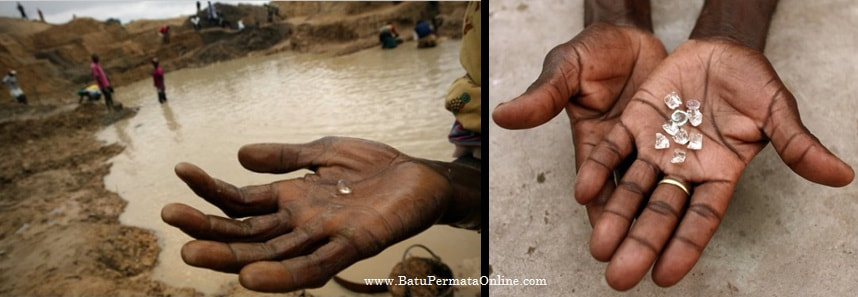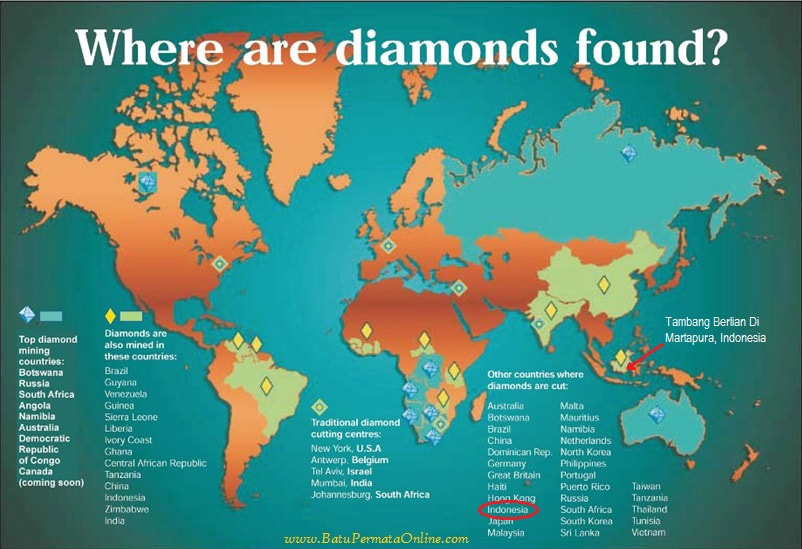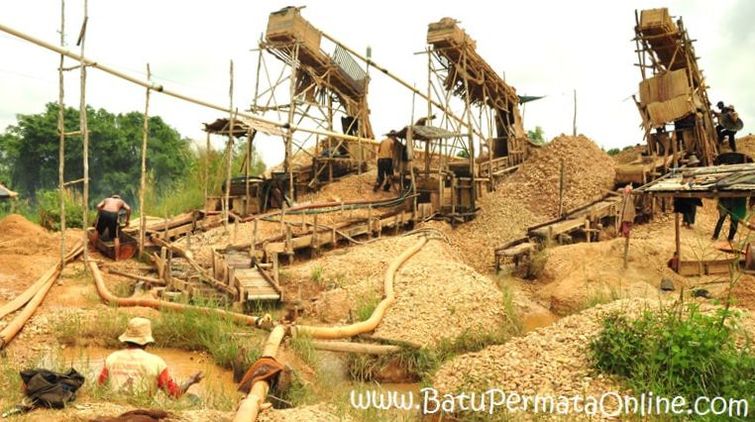Only here Diamond Mines are found
n reality, Diamonds actually aren't very rare. Diamonds are more common than other precious gemstones like Emeralds, Rubies, and Sapphire. In fact, even pure gold in its natural form is more rare than diamonds. Diamonds are made of carbon, which is the most abundant element on earth.
Aikhal (means 'fame') is the biggest diamond mine in the world. It is located in Yakutia, in the far east of Russia. The owner of this mine is one of the biggest mining companies in the world, Alrosa. ALROSA Group is a Russian partially state-owned diamond mining company.. Approximately 130,000,000 carats (26,000 kg) Diamonds are mined every year, with a total value of almost US $ 9 billion, and around 100,000 kg (220,000 lb) are synthesized annually.
Approximately 49% of diamonds come from Central and South Africa, although significant mineral sources have been found in Canada, India, Russia, Brazil and Australia. They are mined from volcanic pipes of kimberlite and lamproite, which can carry diamond crystals, coming from inside the Earth where high pressure and temperature allow them to form, to the surface. Mining and distribution of natural diamonds is the subject of frequent controversy such as concerns about diamond sales from conflict by African paramilitary groups. The diamond supply chain is controlled by a small number of strong businesses, and is also highly concentrated in a small number of locations around the world.
Aikhal (means 'fame') is the biggest diamond mine in the world. It is located in Yakutia, in the far east of Russia. The owner of this mine is one of the biggest mining companies in the world, Alrosa. ALROSA Group is a Russian partially state-owned diamond mining company.. Approximately 130,000,000 carats (26,000 kg) Diamonds are mined every year, with a total value of almost US $ 9 billion, and around 100,000 kg (220,000 lb) are synthesized annually.
Approximately 49% of diamonds come from Central and South Africa, although significant mineral sources have been found in Canada, India, Russia, Brazil and Australia. They are mined from volcanic pipes of kimberlite and lamproite, which can carry diamond crystals, coming from inside the Earth where high pressure and temperature allow them to form, to the surface. Mining and distribution of natural diamonds is the subject of frequent controversy such as concerns about diamond sales from conflict by African paramilitary groups. The diamond supply chain is controlled by a small number of strong businesses, and is also highly concentrated in a small number of locations around the world.
How many diamonds are left to mine?
Diamond reserves have been stable in recent years at 2.3 billion carats, a sufficient level to sustain current annual production for the next 18 years. New pipeline and expansion projects along with currently operating facilities will generate around 172.3 million carats in 2025.
Only a small portion of diamond ore consists of real diamonds. The ore is destroyed, during the lifting process Diamonds on the surface of the earth, are needed not to destroy larger diamonds, and then sorted by density. Currently, diamonds are located in solid diamond fragments with the help of fluorescence X-rays, after which the final sorting step is done by hand. Before X-ray use becomes common, separation is done with an oil belt; Diamonds have a strong tendency to hold on to oil than other minerals in ore.
Historically, diamonds have only been found in alluvial deposits in the Guntur and Krishna districts in the Krishna River delta in South India. India led the world in diamond production since their discovery around the 9th century BC in the mid-18th century AD, but the commercial potential of these sources was exhausted by the end of the 18th century and at that time India was defeated by Brazil where non diamonds -India first discovered in 1725. Today, one of India's most prominent mines is located in Panna.
Diamond reserves have been stable in recent years at 2.3 billion carats, a sufficient level to sustain current annual production for the next 18 years. New pipeline and expansion projects along with currently operating facilities will generate around 172.3 million carats in 2025.
Only a small portion of diamond ore consists of real diamonds. The ore is destroyed, during the lifting process Diamonds on the surface of the earth, are needed not to destroy larger diamonds, and then sorted by density. Currently, diamonds are located in solid diamond fragments with the help of fluorescence X-rays, after which the final sorting step is done by hand. Before X-ray use becomes common, separation is done with an oil belt; Diamonds have a strong tendency to hold on to oil than other minerals in ore.
Historically, diamonds have only been found in alluvial deposits in the Guntur and Krishna districts in the Krishna River delta in South India. India led the world in diamond production since their discovery around the 9th century BC in the mid-18th century AD, but the commercial potential of these sources was exhausted by the end of the 18th century and at that time India was defeated by Brazil where non diamonds -India first discovered in 1725. Today, one of India's most prominent mines is located in Panna.
Diamond extraction from primary deposits (kimberlites and lamproites) began in the 1870s after the discovery of Diamond Fields in South Africa. Production has increased over time and now the accumulated amount of 4,500,000,000 carats (900,000 kg) has been mined since that year. Twenty percent of this amount has been mined in the past five years, and in the last 10 years, nine new mines have begun production; Four more are waiting to be opened soon. Most of these mines are located in Canada, Zimbabwe, Angola and one in Russia.
In the United States diamonds have been found in Arkansas, Colorado, New Mexico, Wyoming, and Montana. In 2004, the discovery of microscopic diamonds in the U.S. resulted in sampling of bulk bulk kimberlite in remote parts of Montana. The Crater Diamonds State Park in Arkansas is open to the public, and is the only mine in the world where community members can dig diamonds.
At present, most of the diamond deposits worth trading are in Russia (mostly in the Sakha Republic, for example the Udachnaya Mir and pipeline pipes), Botswana, Australia (Northern and Western Australia) and the Democratic Republic of Congo. In 2005, Russia produced almost one-fifth of global diamond output, according to the British Geological Survey. Australia offers the richest diamantiferous pipeline, with production from the Argyle diamond mine reaching a peak rate of 42 metric tons per year in the 1990s. There are also commercial deposits that are actively mined in the Northwestern Region of Canada and Brazil.
Diamond Mine in Martapura, Indonesia
Cempaka mine is one of the largest Diamond mines in Indonesia. In August 1965, the mine was in the headlines when miners reportedly found a 166.75-carat diamond.
The famous Kalimantan gemstone is like diamond which comes from diamond mining from Martapura, South Kalimantan. Besides that, there are many amethyst with the best quality in Kalimantan.
In the United States diamonds have been found in Arkansas, Colorado, New Mexico, Wyoming, and Montana. In 2004, the discovery of microscopic diamonds in the U.S. resulted in sampling of bulk bulk kimberlite in remote parts of Montana. The Crater Diamonds State Park in Arkansas is open to the public, and is the only mine in the world where community members can dig diamonds.
At present, most of the diamond deposits worth trading are in Russia (mostly in the Sakha Republic, for example the Udachnaya Mir and pipeline pipes), Botswana, Australia (Northern and Western Australia) and the Democratic Republic of Congo. In 2005, Russia produced almost one-fifth of global diamond output, according to the British Geological Survey. Australia offers the richest diamantiferous pipeline, with production from the Argyle diamond mine reaching a peak rate of 42 metric tons per year in the 1990s. There are also commercial deposits that are actively mined in the Northwestern Region of Canada and Brazil.
Diamond Mine in Martapura, Indonesia
Cempaka mine is one of the largest Diamond mines in Indonesia. In August 1965, the mine was in the headlines when miners reportedly found a 166.75-carat diamond.
The famous Kalimantan gemstone is like diamond which comes from diamond mining from Martapura, South Kalimantan. Besides that, there are many amethyst with the best quality in Kalimantan.
Indonesia is famous for its natural wealth and precious rocks. There is not a single stone that is not valuable to be used as jewelry or building materials and furniture as a commodity that is never empty of enthusiasts.
Especially for precious stones such as gems, quite a lot is spread in the eastern part of Indonesia. One of them is Martapura, a producing place for Kalimantan gemstones. Martapura, which is the capital of Banjar Regency which is part of the South Kalimantan region, is well known to local and foreign communities as the best diamond producer.
Diamond Market in Martapura
There is a diamond market that provides diamonds in a form that has been processed into jewelry. Prices offered vary, ranging from tens of thousands of rupiah to hundreds of thousands of rupiah. The price is adjusted to the rarity and uniqueness of gemstones.
Especially for precious stones such as gems, quite a lot is spread in the eastern part of Indonesia. One of them is Martapura, a producing place for Kalimantan gemstones. Martapura, which is the capital of Banjar Regency which is part of the South Kalimantan region, is well known to local and foreign communities as the best diamond producer.
Diamond Market in Martapura
There is a diamond market that provides diamonds in a form that has been processed into jewelry. Prices offered vary, ranging from tens of thousands of rupiah to hundreds of thousands of rupiah. The price is adjusted to the rarity and uniqueness of gemstones.






